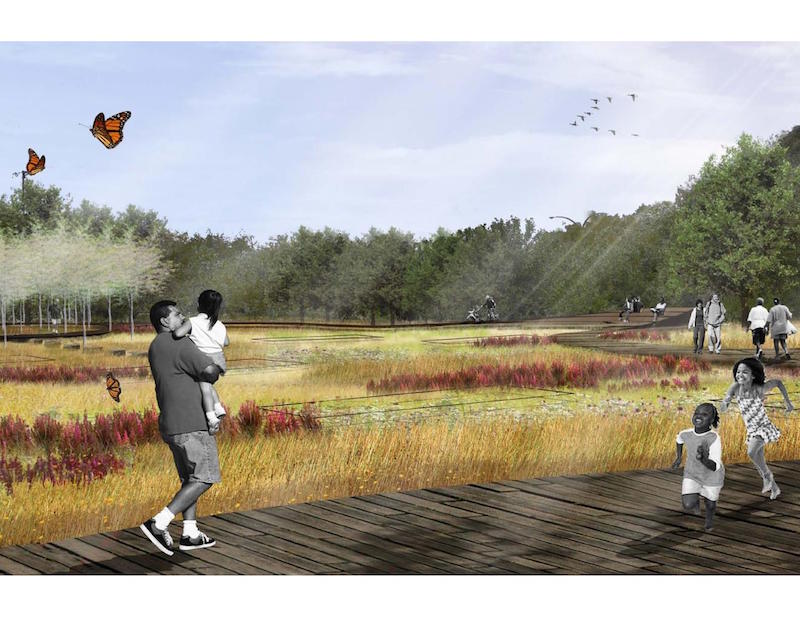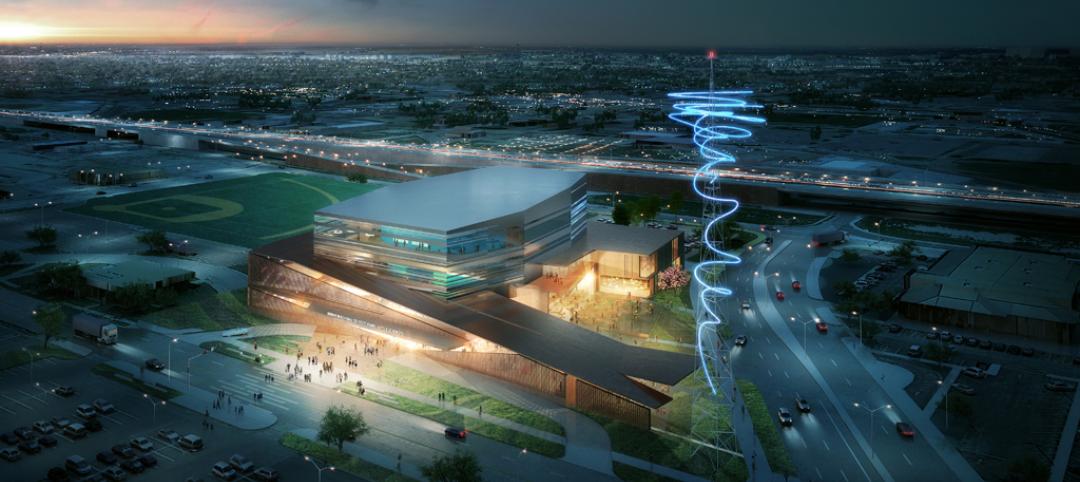The TKF Foundation is a 10-year-old private nonprofit that specializes in creating open, public sanctuaries. Since its founding, TKF has supported the creation of more than 130 Open Space Sacred Places in the Baltimore-Annapolis-Washington area alone.
“We envision a time when every urban community in the U.S. will provide people with opportunities for intimate, intentional daily doses of nearby urban nature through the creation of a system of nature spaces,” says the Foundation’s mission statement.
On May 20, The Naval Cemetery Landscape, a 1.7-acre public space on the site of a former Naval Cemetery on the waterfront in Brooklyn, N.Y., opened. This is the sixth nationally funded site where TKF and its research partners are studying the relationship of nature and human resiliency, and specifically the impact that proximity to nature has on a person’s ability to recover from psychological, social, or physiological stresses.
A team led by Denise Milstein, Director of Columbia University’s Master’s degree program in Sociology, is conducting the study at the cemetery site, which focuses on students of the Brooklyn Green School and on residents of Brooklyn Housing and Community Services.
“It is an excellent example of how green space can foster social cohesion, and the research being done here should offer insights for other city planners on the value such spaces bring to cities and their residents,” said Tom Stoner, TKF’s 81-year-old co-founder.
The Foundation selected the Naval Cemetery Landscape project from 126 that responded to its RFP for a grant. TKF visited more than 30 sites over an 18-month period before making its choice, says Jayne Trentanove, a Foundation spokesperson.
The project is the first open space of the Brooklyn Waterfront Greenway, which when completed will comprise a 27-mile route for pedestrians and cyclists that connects neighborhood parks and open spaces from the Greenpoint section of Brooklyn to Jamaica Bay, Queens.
The Naval Cemetery Landscape’s development was spearheaded by the nonprofit Brooklyn Greenway Initiative in partnership with the Brooklyn Navy Yard Development Corporation.
“As we approach Memorial Day, we are reminded of the significant military history of the Yard, and through the thoughtful landscape design, we hope to honor those roots,” said David Ehrenberg, President and CEO of the Brooklyn Navy Yard.
Marvel Architects and Nelson Byrd Woltz Landscape Architects designed the site in a way that respects its history as a burial ground. New York’s Department of State collaborated on this project, in that since 2004 it has awarded five Environmental Protection grants totaling $3,318,000 to the Brooklyn Greenway Initiative and the Brooklyn Borough President’s office.
The former Brooklyn Naval Hospital Cemetery site is located in the southeast corner of the Brooklyn Navy Yard. The cemetery had been active from 1834 through 1910, and was a burial site for more than 2,000 people. In 1926, the Navy sought to move all remains and inter them at nearby Cypress Hills National Cemetery.

The 1.7-acre Naval Cemetery Landscape is serving as a research site studying the importance of nearby nature of human resiliency, and to evaluate how proximity to landscape affects human well-being. Image: Marvel Architects and Nelson Byrd Woltz Landscape Architects.
Establishing a legacy
TKF Foundation will be closing its doors in December 2017, says Trentanove. But it has laid the groundwork for future urban landscape and restorative places through the research it has conducted over the years, the open spaces it has helped create, and through its national grant program that has provided $4.5 million for six research projects.
Aside from the naval cemetery site, its other grant projects include:
•The Green Road, a woodlands path that runs through the campus of Walter Reed National Military Medical Center in Bethesda, Md. It provides “an oasis of respite” for wounded soldiers and their families, as well as a patient-centered approach to healing;
•A Nature Place in Portland, Ore., where the roof of Legacy Emanuel Medical Center was converted into a 6,500-sf healing and restorative garden that’s open to the public, but whose main purpose is to provide a calming area for the facility’s Cardiovascular ICU and its Family Birthing Center. The effect of that space on patients and their families, on nurses, and on post-partum mothers is being studied;
•TKF has two “Landscapes of Resilience” research sites where the organization and its partners are analyzing how the natural environment can influence and help restore places in crisis. One site—Butterfly Garden & Overlook—is located in Joplin, Mo., on land where homes were wiped out by an E-5 tornado five years ago. A second, under development, is recreating a community garden and large gathering place on the edge of Jamaica Bay in Queens, N.Y. It is located adjacent to two senior citizen housing towers that were severely damaged by Hurricane Sandy;
•TKF is also funding research on why nature improves health outcomes. A team of researchers, led by Marc Berman of the University of Chicago, is evaluating the effects of nature on cognitive functioning. One of the team’s goals is to create a kind of guide that would inform urban planners about what elements they should include in future projects that are most likely to attract people.
A second study, conducted by a team from the University of Illinois at two of TKF’s older sites in Baltimore, is looking at different populations and how spending time in natural settings affects one’s immune system.
Related Stories
Performing Arts Centers | Aug 31, 2016
Sydney Opera House scheduled for $200 million upgrade
Acoustical improvements will be made alongside upgrades in accessibility, efficiency, and flexibility.
| Aug 30, 2016
CONVENTION CENTER GIANTS: A ranking of the nation's top convention center sector design and construction firms
Gensler, LMN Architects, AECOM, Turner Construction Co., and WSP | Parsons Brinckerhoff top Building Design+Construction’s annual ranking of the nation’s largest convention center sector AEC firms, as reported in the 2016 Giants 300 Report.
Cultural Facilities | Aug 27, 2016
Yellowstone Park Foundation receives $1 million donation from Toyota
The money will support new eco-friendly and efficient buildings on the park’s Youth Campus.
University Buildings | Aug 16, 2016
New images of Rice University’s Moody Center for the Arts revealed by Michael Maltzan Architecture
The arts center will foster creativity for making and presenting works across all disciplines
Cultural Facilities | Aug 1, 2016
A retractable canopy at Hudson Yards will transform into a large performing and gallery space
The Shed could become the permanent home for New York’s Fashion Week event.
Cultural Facilities | Jun 30, 2016
Tod Williams Billie Tsien Architects selected to design Obama Presidential Center in Chicago
With experience designing cultural and academic facilities, Williams and Tsien got the nod over other search finalists like Renzo Piano, SHoP, and Adjaye Associates.
Urban Planning | Jun 9, 2016
Triptyque Architecture designs air-cleansing hanging highway garden in São Paulo
The garden would filter as much as 20% of CO2 emissions while also providing a place for cultural events and community activities.
Education Facilities | Jun 1, 2016
Gensler reveals designs for 35-acre AltaSea Campus at the Port of Los Angeles
New and renovated facilities will help researchers, educators, and visitors better understand the ocean.
Cultural Facilities | May 6, 2016
Pod-shaped cable cars would be a different kind of Chicago SkyLine
Marks Barfield Architects and Davis Brody Bond designed a "gondola" network that will connect the city's Riverfront to its Navy Pier.
Performing Arts Centers | May 4, 2016
Diamond Schmitt unveils designs for Buddy Holly Hall performing arts center
The spacious and versatile complex can hold operas, plays, rock concerts, and conferences.

















